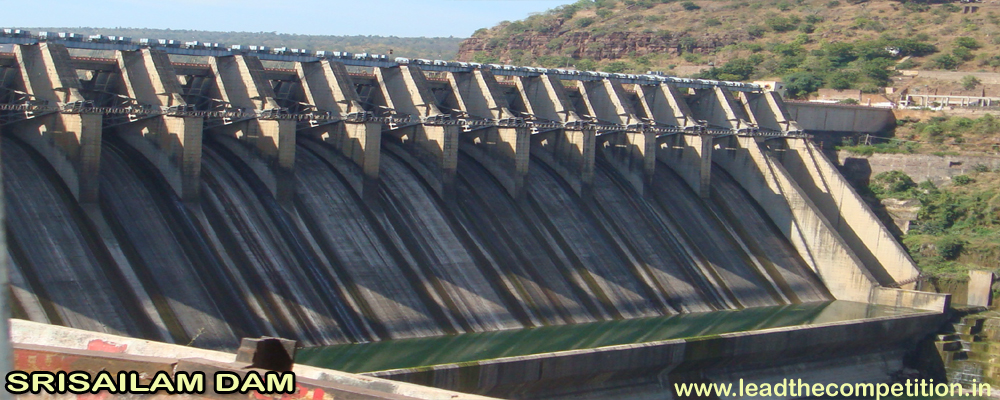Dams and Rivers
*** इस पृष्ठ को हिंदी में पढ़े ***
Dams of the India and Rivers

| Dam | River | State |
|---|---|---|
| Nagarjunasagar | Krishna | Telangana |
| Pochampad (Sri Ramasagar) | Godavari | Telangana |
| Srisailam | Krishna | A.P. |
| Sardar Sarovar | Narmada | Gujarat |
| Ukai | Tapi | Gujarat |
| Hirakud | Mahanadi | Orissa |
| Bhakra Nangal | Sutlej | Himachal Pradesh |
| Pong (Maharana Pratap Sagar) | Beas | Himachal Pradesh |
| Thein (Ranjit Sagar) | Ravi | Punjab |
| Baglihar | Chenab | Jammu & Kashmir |
| Chutak | Suru | Jammu & Kashmir |
| Panchet | Damodar | Jharkhand |
| Maithon | Barakar | Jharkhand |
| Tehri | Bhagirathi | Uttarakhand |
| Koyna | Koyna | Maharashtra |
| Mettur | Kaveri | Tamilnadu |
| Krishnaraja Sagar | Kaveri | Karnataka |
| Alamatti | Krishna | Karnataka |
| Mullaperiyar | Periyar | Kerala |
| Gandhisagar | Chambal | Madhya Pradesh |
| Nimoo Bazgo | Indus | Jammu & Kashmir |
Dams of the World and Rivers
| Dam | River | Country |
|---|---|---|
| Aswan Dam | Nile | Egypt |
| Jinping-I dam | Yalong | China |
| Three Gorges dam | Yangtse | China |
| Nurek dam | Vakhsh | Tajikistan |
| Itaipu dam | Parana | Brazil and Paraguay |
| Hoover dam | Colorado | U.S.A. |
| Note: There are innumerable dams in the world but only a few are listed here keeping in view the scope of this website and that of GK required for competitive exams in India. | ||
Types of Dams
| Type of Dam | Brief description | Example |
|---|---|---|
| Earth Dam | Earth dams are constructed by laying layers of scientifically compacted soil or soil-rock mix to form embankments. They are trapezoidal in shape. The safety and stability of the dam is ensured by the quality of soil used and the efficiency of design. | Hirakud Dam |
| Rock-fill Dam | These are constructed with loose rocks and boulders instead of soil. Obviously, workmanship plays a crucial role in ensuring safety and reducing seepage. | Tehri Dam |
| Gravity Dam | Gravity dam are constructed with mass concrete. Such dams resist the flow of water by their sheer weight. | Bhakra Dam |
| Arch Dam | Arch Dams are made of thin RCC section. They are curved in plane, with their concave side facing downstream. They retain substantial part of water pressure by virtue of their shape. | Idukki Dam |
Test Yourself on Rivers and Dams
www.leadthecompetition.in
Match the Dam with the River
1. Ukai Dam
2. Tehri Dam
3. Mettur Dam
4. Bhakra Nangal Dam
5. Nagarjuna Sagar Dam
6. Pong Dam
7. Maithon Dam
Merits and demerits of Dams
Merits
- Water storage: Dams allow for the storage of large volumes of water which can be used for various purposes such as drinking water supply, irrigation for agriculture, and industrial usage.
- Hydropower generation: The stored water in reservoirs is released under controlled conditions, passing through turbines to generate electricity. Hydropower is a clean and renewable source of energy that reduces dependence on fossil fuels and helps mitigate greenhouse gas emissions.
- Flood control: During periods of heavy rainfall or snowmelt, dams can store excess water and release it gradually, reducing the risk of downstream flooding.
Demerits
- Displacement of communities: Construction of dams requires large areas of land and since river banks are well populated, rural communities face evacuation and loss of agricultural land and hence livelihood.
- Environmental Damage: Construction of dams causes alteration of natural river ecosystems and affects aquatic life. Secondly, where forest areas are required to be cleared for creating storage facilities wildlife is affected considerably.
Rivers Quizzes
Quiz on Rivers, Dams, Cities Quiz on Rivers of the World Quiz on Rivers, Origins, Tributaries Quiz on Rivers - Misc InfoWARNING
A lot of creative effort and time goes into development of pages on this site. Unscrupulous publishers copy and paste the content disregarding the protection offered by the Copyright Act, 1957. Such violaters are hereby warned of strict legal action if any of the content from this website is found to be copied and published elsewhere in any form, digital or otherwise.